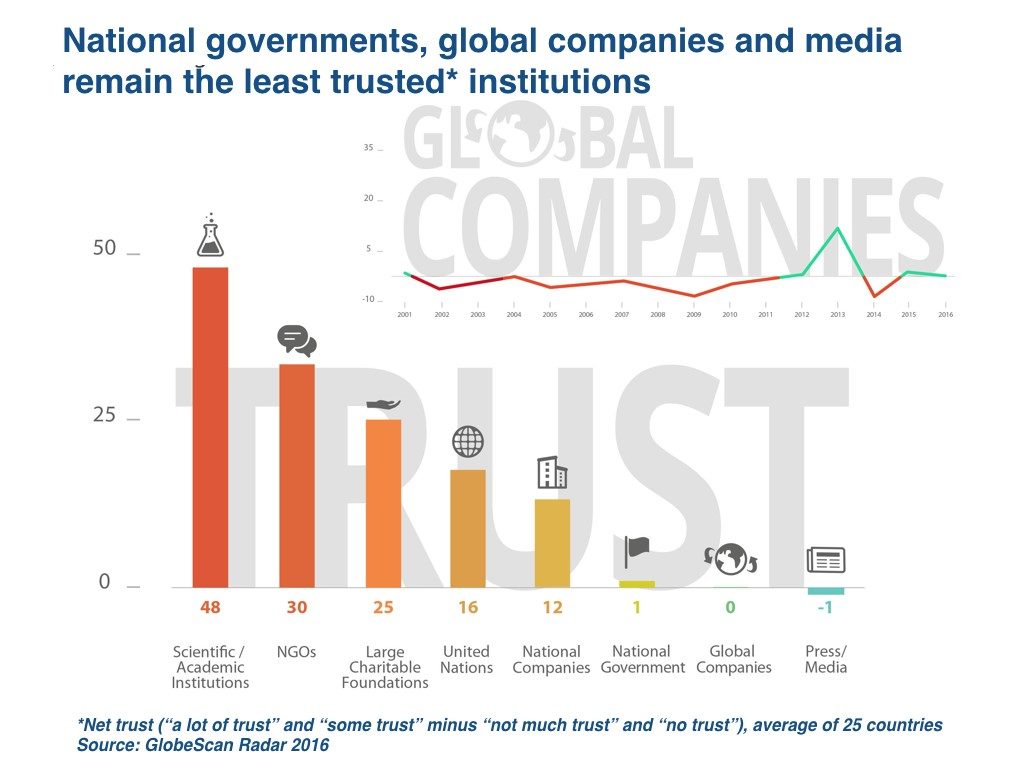Author: Peter Paul van de Wijs
In my last blog I mentioned having the wrong objectives as a key reason for failing stakeholder engagement programs. In this edition I am taking a closer look at 5 objectives that can really make a difference for a company.
According to Sir Richard Branson succeeding in business is all about making connections. Trust is the foundation of successful long-term connections and relations. Yet, as for example independent research consultancy GlobeScan’s long-term trust data shows, companies have systematically ignored this. Or, more precisely, they have taken a very limited view of the need to build lasting relations, and the trust those require.

Obviously the majority of companies underestimate the importance of reciprocity in relations and they have a limited view of the groups they need to build strategic relationships with. As a result these companies not only take a gamble with their societal license to operate but also miss key growth opportunities. As the following examples illustrate, understanding the benefits for both company and stakeholders opens up wonderful new business opportunities for growth and/or reputation enhancement. They all take strategic stakeholder engagement beyond the narrow idea of needing to build good relations with a few selected audiences to manage potential risks.
- Strategic Stakeholder Engagement supports the achievement of business objectives.
When Unilever developed its Sustainable Living Plan, the company reached out to a wide range of stakeholders to understand their expectations and perspectives. This input was essential for the development of what is widely regarded as a groundbreaking growth strategy based on sustainable principles.
- Benefits to Unilever: identification of the right topics to address, understanding of the expectations of the stakeholders regarding the company’s performance and broad public support for the goals.
- Benefits to stakeholders: the opportunity to ensure that a large corporation addressed their concerns in realistic, measurable action plans.
- Strategic Stakeholder Engagement provides access to knowledge and ideas, which can stimulate innovation and, even, co-creation of products and solutions. While at the same time providing an opportunity to become part of designing future products that meet stakeholder needs and reflect their values.
At events across the United States, GE invites design thinkers to participate in an open innovation process called GE Garages. Participants work in labs outfitted with 3D printers, injection moulders, laser cutters and more to bring their wildest ideas to life.
- Benefits to GE: identification of new ideas and people that can help develop these ideas.
- Benefits to stakeholders: access to a community of like minded people, opportunities to share ideas and, maybe, even find a job, all while having some fun (personal development).
In 2008 the The LEGO Group started a new website called LEGO Ideas which invites customers to submit ideas for new LEGO Products and help select the ones that are put into production.
- Benefits to LEGO: opportunities to strengthen relations with ‘hard core’ customers, develop products that align with customer interests and cut design costs.
- Benefits to stakeholders: opportunity to share their knowledge and ideas, recognition and fun. As an extra incentive the original designer also receives 1% of the royalties.
- Strategic Stakeholder Engagement enhances a company’s reputation by demonstrating a commitment to address societal needs, expectations and challenges as well as business challenges. And builds additional business.
To address concerns from customers regarding food waste, Intermarché, the 3rd largest supermarkets chain in France, decided to sell (30% cheaper) non-calibrated and imperfect fruits and vegetables: “the inglorious fruits and vegetables”. Since the launch of this campaign retailers all over Europe have started similar campaigns.
- Benefits to Intermarché: 1.2 tons of sales per store in the first 2 days of the campaign, positive reputational impact (300% increase in social media mentions in first week).
- Benefits to stakeholders: Addresses the public outcry over food waste and odd EU rules. Farmers got a better price for their crops.
Here you can see the campaign: https://adsoftheworld.com/media/print/intermarche_grotesque_apple
- Strategic Stakeholder Engagement provides a platform for stakeholders to address their concerns in a constructive manner and work on solutions.
When cutting trees on their properties companies in the Netherlands have to replant an equal amount of trees somewhere else. Typically they will do this on their own property. The Community Advisory Panel from DOW Benelux convinced the company to work with local farmers and place the trees on their land in stead; further away from Dow’s production location and thus addressing concerns of ‚visual pollution‘.
- Benefits to DOW: The company still met legal requirements while at the same time addressing a long-standing societal concern and strengthening its reputation.
- Benefits to stakeholders: The trees now block the view on the chemical facilities enhancing the perceived quality of life in the area.
- Strategic Stakeholder Engagement provides an opportunity to stakeholders to be part of a community they aspire to be part of. They can use their engagement as a means to ‘badge’ themselves and differentiate them from peers.
The San Francisco ride-sharing start-up LYFT recently raised $83 million and expanded to 24 new markets. It asks riders to pay a suggested donation based on distance travelled. All LYFT cars sport bright pink moustaches and riders are encouraged to give drivers fist-bumps when they first get in the car.
- Benefits to stakeholders: cheap transportation, opportunities to meet like-minded people, for drivers an opportunity to make some money.
- Benefits to Company: Opportunity to build strong relations with a highly committed customer base and ability to reach out to new drivers with a compelling story.
Each of these examples is compelling in its own right and was initiated to address a specific challenge. However, while reviewing these case studies it struck me that there is good news for all companies considering to step up stakeholder engagement. The common factor of all these is the absolute willingness by the stakeholders to engage if a program is designed correctly. So, there is really no excuse for missing the opportunities co-creation and cooperation offer companies.
About Peter Paul van de Wijs

Peter Paul van de Wijs is senior corporate communication, advocacy and stakeholder engagement strategist. Over the past 20-years he has helped businesses and non—governmental organisations capture the opportunities and manage the reputation risks linked to stakeholder expectations. He is the former Vice President, Communication and Engagement at the LEGO Foundation, ran his own consultancy focused on reputation and sustainability, was a member of the Executive Team of the World Business Council for Sustainable Development and held various leadership positions at The Dow Chemical Company.
Twitter: @ppvdw
Skype: vandewijs